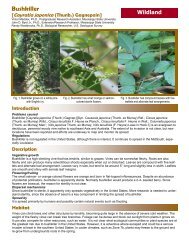RATopic1_95 - Geosystems Research Institute - Mississippi State ...
RATopic1_95 - Geosystems Research Institute - Mississippi State ...
RATopic1_95 - Geosystems Research Institute - Mississippi State ...
Create successful ePaper yourself
Turn your PDF publications into a flip-book with our unique Google optimized e-Paper software.
Sensory Structures on the Antennae of the Cactus Moth<br />
Richard L. Brown and Sang Mi Lee<br />
Typical of all Lepidoptera, the antennae of cactus moths, Cactoblastis cactorum, have sensory structures for detecting<br />
phermones, locating host plants, and detecting environmental conditions. Six types of antennal sensillae are ubiquitous<br />
in Lepidoptera: 1) Sensillum trichodeum (phermone receptors in males, plant volatile receptors in females), 2) Sensillum<br />
basiconicum (plant volatile receptors in females); 3) Sensillum auricillicum (plant volatile receptors in females); 4) Sensillum<br />
coeloconicum (olfactory); 5) Sensillum chaeticum (taste and mechanoreceptors); and 6) Sensillum styloconicum<br />
(temperature and humidity sensors). Although previous research has documented the response of various cactus moth<br />
sensilla to plant volatiles, no information is available on the types, distribution, and relative abundance of the various<br />
antennal sensilla in the cactus moth.<br />
<strong>Research</strong> is in progress on the sensilla of<br />
female and male antennae of the cactus moth<br />
to determine the types of sensilla present,<br />
their relative abundance, and their distribution<br />
on the individual antennal subsegment<br />
(flagellomere). Scanning electron microscopy<br />
(SEM) has been combined with microscope<br />
slide preparations of de-scaled antennae to<br />
obtain diversity and distribution of sensilla.<br />
Some sensilla, e.g., coeloconica and chaetica,<br />
are easily identified with a compound microscope,<br />
but others require use of the SEM for<br />
identification.<br />
The number of flagellomeres (“segments”)<br />
were counted in the antennae from five individuals<br />
of each sex of the cactus moth. The<br />
number of flagellomeres range from 60 to 89<br />
( = 76) in males and 67-79 in females<br />
( = 73) in females. Variation in number<br />
of flagellomeres was correlated with the forewing<br />
length.<br />
Figure 1. Sensilla on flagellomere near middle of female antenna of cactus<br />
moth, a – auricillium, b – basiconicum, c – coeloconicum, ch –<br />
chaeticum, sc - socket of scale, t – trichodeum, types A and B.<br />
Cactus moth males and females have all six types of antennal sensilla, with sensilla trichodea represented by two types,<br />
A and B (Fig. 1). Examinations of SEM images and slide mounts have revealed that sensilla are restricted to the ventral<br />
half of each flagellomere whereas the remainder is covered by scales (Fig. 1). Examinations of slide mounts revealed<br />
that a female antenna averaged 3.6 sensilla coeloconica for each of 68 flagellomeres, whereas a male antenna averaged<br />
4.9 sensilla coeloconica for each of 69 flagellomeres. These data suggest that this sensillum in the male is a more important<br />
receptor for olfaction of chemicals than in the female. Sensilla chaetica, which are known to be gustatory receptors,<br />
are present in almost equal numbers (either one or two present on each flagellomere) among males and females. In females<br />
the sensilla chaetica are positioned at the apical end of the ventral surface of each flagellomeres. In males, these<br />
sensilla are irregular in position, sometimes occurring on the dorsal surface intermixed with scales. Sensilla stylonica,<br />
which respond to temperature and humidity, are present on the apical margin of each flagellomeres of the apical twothirds<br />
of the antenna in each sex.<br />
Additional antennae need to be examined to determine variation in distribution and number of sensilla. Additional scanning<br />
electron microscopy is needed to differentiate sensilla trichodea and sensilla basiconica. These data on diversity,<br />
abundance, and distribution of sensilla in the cactus moth will be compared with those for the native cactus moth, Melitara<br />
prodenialis to determine any differences between the two species for host location.<br />
2009 USGS Annual Report 21 <strong>Mississippi</strong> <strong>State</strong> University’s <strong>Geosystems</strong> <strong>Research</strong> <strong>Institute</strong>




